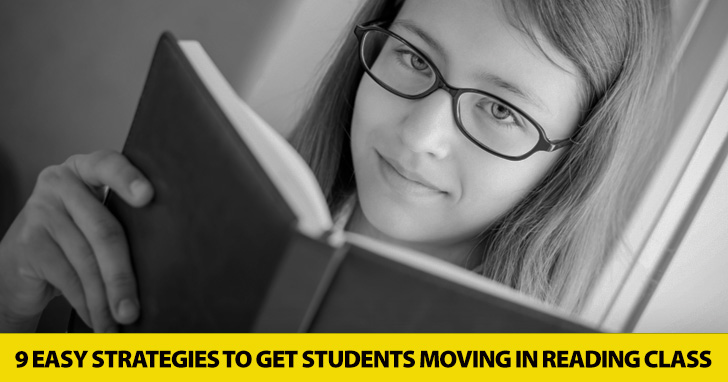7 Specific Strategies for Your Next Reading Class


But turning pages, no matter how many, doesn’t take much movement. And we all know the more your students move, the more easily they will learn and retain what they are learning. Plus, when you get your students moving in class, your kinesthetic learners will love you for it. So if you want to get your students moving in reading class but need some ideas to get you started, here is just what you are looking for.

If your students are reading a nonfiction article, odds are headings will divide the different sections of the text. Try cutting apart the headings and the article text and have students work to match them with each other on their desks.
You can have students sequence events in a story two different ways. One is to give them the original text and have them figure out the correct order of the paragraphs. Another way is to give them a summary after they have read a larger piece and have them sequence the sentences in the summary. If you want your students to read the text ahead of time, sequence a summary. If you want than to read the material for the first time in class, have them sequence the paragraphs in the passage.
Particularly if you have young students, they will enjoy this activity which has them recreate a scene with props. You can use any props, but it can be fun to give students finger puppets or small pictures they can color and cut out when they act out the story. Then put a paragraph on the board which describes a scene with the puppets your students now have. Have students read the paragraph and then arrange their puppets the same way on their desk or perform the actions that the paragraph describes.
This activity is extremely simple and takes almost no preparation other than choosing your reading passage. Have students read the selection, and then have them make two signs – true and false. If you want, you can let students decorate their signs. Then read a statement to your class. If the statement is true, they hold up that sign. If false, they hold up the other one. Your students will get their bodies involved and you will get a good read on who understands what they are reading with nothing more than a quick look.

You can do this activity either in your classroom or outside. Divide your reading selection up into five to ten logical sections. If you are using a picture book, put every two page spread on a single sheet. Then post these selections around your classroom or in different areas outside. Number the passages so students go to them in order. With each passage, post a comprehension question about that passage. You can make these questions simple or more difficult depending on what you want from your students. Then have your students move from one passage to the next, reading the selection and answering the comprehension question before moving on to the next selection. Once students have completed the passage, go over the answers to the questions.
This activity is similar to the last in that the reading selections are posted around the room. This activity, though, works best with nonfiction. In this activity, you will have removed the headings from the different sections and written or typed them out for your students. Give each student a copy of the different headings. Then on the wall under each reading section, post an envelope. Have your students write their names on the back of each section heading and then put each heading with its section in the appropriate envelope. Once everyone has put his headings in the envelopes, go over which heading goes with each section. You can see who got the answers right by looking at the names on the slips of paper.
If your students have already read a selection either at home or in class and you want to check their comprehension, try this activity. Give your students several multiple choice questions on the passage they have read, but do not include the answers on their papers. Instead, post the answers from which they can choose in different areas of your classroom. You might want to have all the A answers on one wall, B on another, etc. or you might just post all the choices for number one in one place, number two in another, and so on. Either way, your students will have to move around the room to get the options for their answers. As a bonus, you can have students try to answer the questions on their own before getting up to look at the answers on the walls.
This activity is similar to a jigsaw in that one student will read each section of a reading assignment and then will give that information to the rest of their group. Divide your reading selection into a logical number of sections, and then post each section in one area of your room. You will probably need multiple copies of each section posted so more than one student can read at a time. Then put your students into groups of the same number. So if you have four different sections of the reading passage, you would put your students in groups of four. Then one person from each group goes to a posted section and reads it. The students then come back together and share with each other what was in their section so everyone in the group knows all the information from the entire reading selection. You can then have each student answer comprehension questions on the entire passage.
You won’t really have your students writing on the walls in this activity, but they will be interacting with the text on a large scale. To start, project your text on the front board. Then, have students mark certain portions of the text. You might have them underline answers to certain questions or mark vocabulary words. You can also have them make notes in the margins (on your board) of things that strike them as interesting, confusing, shocking, or funny.
Try these or other ways to get them moving, and you will see how it impacts their learning.